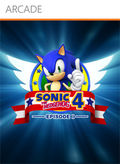You can trust VideoGamer. Our team of gaming experts spend hours testing and reviewing the latest games, to ensure you're reading the most comprehensive guide possible. Rest assured, all imagery and advice is unique and original. Check out how we test and review games here
The title screen sets the precedent. Sonic poses behind a familiar looking emblem, waggling his finger expectantly at the screen as chirpy chip tune music plays in the background. Kids of the nineties will bask in the nostalgia radiating from the screen, fingers twitching as old cheat codes materialise in their minds. As he stands there, beckoning players to press the start button, we’re told exactly what Sonic 4 is all about. Its retro Sonic, on next-gen consoles, with HD visuals bringing to life new levels based on old environments. Everything about it is a contradiction, but therein lays the charm.
As I play the opening few acts, and the familiar chime of collected rings fills the office, an audience slowly gathers around me. They leer at the screen, squabbling with each other over every detail that doesn’t fit the mental image they have of Sonic 4 in their heads. Few games this year have commanded the attentions of the VideoGamer.com staff with such authority, but after 16 years who can blame them? This is indicative of many gamers because, despite his descent into mediocrity in recent years, Sonic the Hedgehog is a character that is still held close to gamers’ hearts. Subsequently, Sonic 4 will be the subject of endless scrutiny; even at preview stage the internet was ablaze with uncertainties about the game.
There’s certainly no denying it looks great; clean, crisp and modern in all the right places. The jittering flowers, chequered marble of the platforms, vibrant blue skylines, fluffy white clouds – it’s classic Sonic, and yet at the same time it’s not. It’s new and trendy, revamped for a 2010 audience with fancy HD visuals. Sonic himself looks pretty dapper, too; he’s leaner, lankier, and spikier, bounding around each level with slick new animations. While the physics might be slightly different (a point I’ll address later on), Sonic handles with all his moves left as exactly as you remember them. Or near enough.
In a controversial move, developer Dimps has added a new ability to the blue blur’s repertoire or, to be more precise, a move that’s never been used in a 2D Sonic game. Pressing the jump button whilst already in the air will launch a homing attack, and if there’s a monitor or badnik in the vicinity, Sonic will make a beeline for it in his curled-up form. This mechanic is tied into the platforming well, allowing Sonic to dart from enemy to enemy, stringing together entire lines of foes to reach otherwise inaccessible locations. Far from ruining the classic formula (which was the fans’ main concern), the addition of the homing attack adds another layer of depth to the platforming, which can only be considered a good thing.
It doesn’t take long to readopt the mentality required to play Sonic, and you’ll race through Splash Hill zone in no time at all. At this point, three other zones become available, all of which are selectable from a fancy new map screen. This offers players the chance to navigate the dark waterways of the Lost Labyrinth, enjoy the neon-lit nightlife of Casino Street, or explore the sprawling industrial utopia of the Mad Gear zone – but you do these in any order you want. Each environment harks back to a Sonic zone of old, with the design and atmosphere of Sonic 2 coming through the strongest. Each zone is also split into four acts, the fourth taking the form of a boss battle against the ever-persistent Dr Eggman.
The story isn’t worth delving into here – all you need know is that Sonic is rescuing poor furry animals from the clutches of the evil Dr Eggman. As with the levels themselves, each boss battle is intentionally reminiscent of that from a previous game, except on each occasion there’s a twist. Your old-school logic will only take you so far, the twists aiming to keep veterans on their toes. The first boss sees Dr Eggman in his carrier, swinging a wrecking ball across the screen. You know the drill. Wait on the raised platforms, jump on his noggin whenever he gets close enough, rinse and repeat. It’s a routine burnt into the memories of a generation of gamers. This time, however, he’ll fling the ball 360 degrees over his head, putting the age old plan to pot. It’s the same, but it’s different – a sentiment at the very heart of Sonic 4.
Unlike previous entries in the series, death will no longer force you to play the whole thing again. The map screen allows players to choose which zone and which act you’d like to play, meaning you’re never more than a few minutes away from the point you surrendered your last life. This is a double-edged sword. While Sonic-nuts might disapprove of the get out of jail free card, less patient players will appreciate the fact they don’t have to play the entire game again to fight the last boss.
Just as you might expect, if you manage to keep hold of 50 rings or more, a giant gold ring portal will await you at the end of the level. The special stages in Sonic 4 base themselves around those from the original spinning sections from Sonic the Hedgehog, except once again there’s a twist; you’ll have to spin it yourself, ensuring Sonic falls through the right sections in order to reach the Chaos Emerald lurking at its core. Later special stages are particularly troublesome, asking that Sonic collect a ludicrous amount of rings in an incredibly small time frame. Collecting all 7 chaos emeralds is no easy task, but then again it never was.
Variation is certainly not an issue in Sonic 4, with several new mechanics introduced over the course of the game. Splash Hill zone sees Sonic swinging from vine to vine, the Casino Street zone sees him being fired from a canon, while in the Lost Labyrinth he can be found riding giant balls of stone through derelict mines. Some of these gimmicks, however, detract from the fundamental appeal of Sonic: speed. The second act of the Lost Labyrinth level, for example, furnishes Sonic with a torch, which can be used to light candles around the level. You can only see a few feet in front of you at any given time, enforcing the need for caution and care. While the torch gives rise to some interesting puzzles, it brings the pace of the game to a crashing halt. Since when was Sonic about caution and care?
And so we reach the dark and uncomplimentary section of this review. The camera is zoomed in too close to ol’ Blue, restricting the player’s view of the level. At high speeds this becomes particularly annoying, and you’ll run into badniks before you’ve even had time to realise they were on the screen. Reaching these speeds raises another problem: Sonic is too slow, taking half an eternity to reach maximum velocity, which often can’t be attained without the aid of boosts and spinners anyway. I’m aware that Dimps has tried to keep Sonic the same speed as he was back in day, but it’s 2010 damn it, and the game simply feels too sluggish. In combination with the mechanics I mentioned earlier, it feels as if the game has lost its fluidity – its rhythm.
The music, too, is cause for concern. While it’s distinctly ‘Sonic’ in theme, it lacks that catchy twang that characterised its predecessors. You won’t find yourself whistling anything from Sonic 4 after you’ve stopped playing. If anything, you’ll be whacking on some of your own music to make things more exciting. Perhaps I’m being unfair; the music’s more bland than bad – but I doubt I’m alone in expecting more from the game musically.
The whole episodic nature of the game bugs me too. Sonic 4 is too brief, and although time attack and online leaderboards offer decent replayability, the game as a whole feels needlessly short lived. Why SEGA couldn’t have released the whole thing as one package escapes my comprehension. Surely that would have had a far greater impact than a meagre four zones? It’s not a narrative based experience, after all, and splitting up the content therefore serves little purpose. SEGA had better get Episode 2 out the door fairly sharpish, too, or the whole thing will have been without purpose.
This isn’t the sequel we’ve been yearning for all these years. It’s a fancy looking homage; a game that regurgitates old levels with shiny new visuals. Sonic 4 does a fantastic job of recreating the retro Sonic experience that defined many a childhood, but ironically this could be considered its biggest shortcoming. Depending on which camp you fall into regarding Sonic, however, a homage is no bad thing. The platforming is undeniably good fun, marrying old school platforming with some interesting new mechanics. Despite its shortcomings, there’s a lot of fun to be had here, and its flaws can be easily overlooked. Sonic fans will likely be blind to these blemishes anyway, it’s simply that charming. Sonic Team just need to make sure the blue Hedgehog’s shoes are fastened a little tighter for Episode 2.
Sonic the Hedgehog 4: Episode 1
- Platform(s): iOS, PlayStation 3, Wii, Xbox 360
- Genre(s): Platformer

/https://oimg.videogamer.com/images/564e/sonic_4_episode_1_19.jpg)






